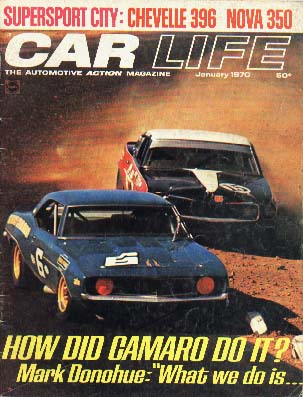

THE WICKED FLEE when no man pursueth. Roger Penske does not flee when pursued. Before the West Coast Trans-Am races, the finsih of the 1969 season was clear. Penske"s Sunoco Camaro team would win.
We must find out how Penske and his crew do it, but how? we don't know any spies and we can't afford bribery. Besieds, we'd proably get puched in the nose, and we are writers not fighters.
Start at the top, with Penske him-self, Sure, he said. Here's where we'll be working on them between races. Drop in any time, with notebook, camera, sketchpad and tape measure. We have no secrets and we can't afford to cheat.
Accusations are easy to make, and hints and snide remarks fell like rain during the 1969 season. There were some flagrant examples of rule breakage and bending. But Penske is right. He can't afford to cheat. There are too many eyes on him, and he would lose more than one race if he was ever caught.
It's worth noting here that Penske has allways been one step ahead of the field when it comes to making the book work for the car. He's been in racing, as a title-winning driver before he became an entrant, for 10 years. He probably holds the record for being protested. And not one protest has ever been upheld, Not one.
Builsing a Trans-Am winner starts at the factory. This is not to say the Sonoco team is a factory team. If actual money changes hands, nobody has ever found the pipeline, and it's not for lack of effort, inside General Motors and out. The only fair conclusion is that Penslke and the facory trade information and advice, just as Penske and the factory say they do.
The results of this interchange show up in the homologation papers, the list of parts and specifications that determine what can be used on a Trans-Am car and what can't . The manufacturer must do this for the entrant, and Cheverolet does it, for Penske and anybody else who wants to go racing with his Camaro.
But unlike Ford, which is willing to design, manufacture and holmologate anything that could possibly be needed for racing, Cheverolet engineering must be able to assign hte design ocst to some finite account,. There is no racing budget at Chevy, so most of the special parts wind up as "Heavy Duty" and work their way into real honest production. In other workd, if you were smart enough, you were smart enough, you too, could build a Camaro as fast as Mark Donohue's, while on the other hand, just to get the right parts out of Ford you'd have to at least be named Carrol Shelby.
After making sure all the requisite options are registered, the next thing is to establish a technical rapport with the factory, Here Penske made a very wise move early in his association with Chevy. With every enthusiast engineer in the house wanting to get involved in the racing project, and their enthusistic bosses more than willing to let them. Penske put his foot down. He had seen the factory people overrun the Shelby works and would have none of it in his team. He would like only one engineer, thank you and a liasion man to coordinate the technical info passing in both directions, This kept the operation small, efficient and extremely fluid, yet when major technical assistance was needed it was available.
Penske preferred using his own people. Something that isn't commonly known is that one of the better racing engineers in the country is Mark Donohue. He is not only the Penske team number one driver, he is also the chief engineer. He makes the final decisions about various suspension changes he does much of the design work, and all the test driving. If any one man can be called responsible for the winning design it has to be Donohue. He is ably backed up by Chuck Cantwell former Shelby Racing team manager., much of whose time is spent on the drawing board between races, He, too, handles much of the conceptual design, supervises the manufacture of the special parts, and takes care of the complicated logistics of operating a racing team and supplying parts clear across the country.
Each car is cared for by a chief mechanic and a helper. Earl McMillan, a long time Penske mechanic, handles the Donohue car. while Woddy Woodward takes care of Bucknum's mount. A pretty small operation, about one quarter the size of any opposing them. About the only work handled by the factory is the stuff the team has no facilities for, such as computer time and elaborate testing programs.
The Penske Camaros start life as nothing more than a pile of "white" parts-components without paint. The factory has nothing to do with chassis construction, Penske gets the parts through the usual channels of his Chevrolet delarship. The unit-body section is lightened where possible (we could find no evidence of acid dipping-usually dectedtable by the deterioration of spot welds and the roll cage is welded in, becoming as much spaceframe as roll-over structure. The front subframe is all rewelded, the roll cage is extended to meet the forward rails and all unnecessary brackets and bolts are eliminated. The front fenders and grille assembly are also reinforced, unnecessary metal is removed, and the panels are arranged so the whole assembly attaches by four bolts, this facilitates easy removal for accessiblitiy to the major mechanical componenents.
Probably the biggest secret of any Trans-Am racer is the way the suspension works. Standard Ponycars have poor geometry and even worse torque control. They were meant to be cheap first, sophisticated second. It is a tribute indeed that the racing teams have made sophisticated racing cars out of what basically are inferior designs (Most full-sized sedans have vastly superior suspensions.)
The major change is the camber change of the front wheels. Standard suspension allows the wheels to lean out during cornering roll, which reduces the cornering power. And since rules prohibit relcation of the suspension pivot points, the improvement must come from subtile adjustment within the existing design. A favorite trick last year amongst all the teams was to lower the inside upper A-arm pivot point. SCCA got wise to this though and now measures it at the tech inspections. For the 69 Camaros, a slightly longer spindle was homologated effectively accomplishing the same thing without breaking any rules.
Next, eccentric bushings of Delrin (a tough space age plastic material) replace the usual rubber bushings and are used to lower the upper A-arm pivot, and raise the lower. The entire car is also lowered, giving the lower A-arm a near stock angle, while pulling the upper arm into a much steeper angle.
The resulting geometry is much better but the extreme static
negative camber used (3 degrees) indicates that it is still far from
ideal. Still, within the normal alignment adjustment a small amount
of anti-dive is used, by tipping the upper A-arm axis slightly
towards the rear. Chevrolet has various rates of front spring coils
available on a special parts list and these are changed to suit the
specific course. There are also several front anit-roll bars
cataloged but the Penske cars now use a custom made version with the
lever arm length adjustable for tailoring the roll rate. This is
simpler and faster than having to swap the entire bar as would be
required with the factory parts.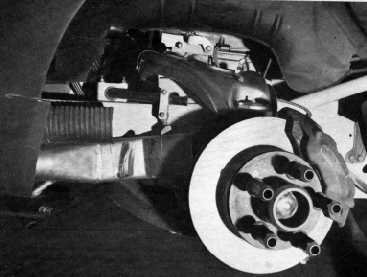
Power steering was tried early in the season, and although it reduced driver fatigue, it was one more part subject to failure (which it did). When the chips went down early in the season, they decided to eliminate all undeveloped ideas to concentrate on winning. The optional quick 17:1 manual steering (RPO N44) is used, and with the big tires, it is horrensously stiff. At speed it lightens, but drivers MUST stay in good physical shape to drive the two to three hour races and avoid accident causing fatigue. Only trick done to the steering is one subtle geometry modification, A small spacer is placed between the steering arm and the tie rod, to lower the steering arm and the tie rod, to lower the tie rod end, causing its arc during suspension travel to be compatable with that of the A-arms, eliminating bump and roll steer.
As the owner of any hot Ponycar will tell you, the worst flaw on these chassis is the rear axle location. The classic Hotchkiss drive is standard fare on all Ponycars, using only the leaf spring to control torque reaction, spring wrap-up under braking and aceleration is common. Making the spring stiffer helps, but the ride suffers. Torque bars will eliminate wrap-up, but induce a bind, no matter how carefully the pivot point is selscted. Challenging problem.
Ford sidestepped it by using two radius rods on each side and taking the locating function away from the spring which sits loosely in slotted mounts.
The Camaros have a more interesting solution. They use no control arms of any kind. The springs are built eccentric, that is, the forward portion is much stiffer than the rear, so that the forward portion acts more as a link than a spring. The rear portion supplies most of the springing. This affords good axle control without having to go super stiff in spirng rate.
As exhibited on the race course they are noticeably softer than the competition. These springs also have a very long effective radius of rotation designed in. i.e. the effective center is much further forward than normal, so that during suspension travel, the axle describes a very flat arc, reducing bump and roll steer to a minimum.
Lateral location is provided by a track or Panhard bar. Although a centrally located Watt link achives straight line travel, it also gives the axle a decidely unnatural geometry. Suppose a bump is encoundered by one wheel. The axle's natural tendency is to ride over the bump by rotating about the opposite wheel. If the axle is constrained in the center, the axle will sill rotate about this pivot point causing a like disturbance at the opposite wheel (a slight inward scrubbing movement). With a Panhard bar, the axle is allowed to move in a more natural fashion curing one wheel bump, but does cause a lateral movement when both wheels bump. It's a trade off. Stability in a corner is more desirable than stability on the straights. Placement of the Panhard bar is also a very ticklish proposition. Located wrong, it can cause a jacking action that would terrorize even the most jaded owner of an early Corvair. Jacking isn't the word for it: More like pole vaulting. Obviously more than the drawing board time of Mark Donohue went into the design of these springs and Panhard bar. It was the result of much computer time.
Delron bushes were also used at the rear springs, and a half inch adjustable andi-roll bar is mounted above the axle. Koni adjustable shocks are used all the way around. One set lasts all season. Incredible.
The rear axle itself is remarkably standard. Although the rules allow the use of full floating axle shafts (hubs fully supported by bearings at the end of the houding) the team no longer uses them. Floating axles are primairly a safety feature: If an axle breaks, the wheel doesn't come off. Penske axles don't break, the full floaters are heavier, and one such floater caused a leak that put one car out of a race, so they have gone back to the standard Chevy hardware. Hubs and axle shafts are crack-checked between every race anyway, and replaced as required. The normal Chevy positraction is fitted, with the clutches shimmed to tighten the differential action. This has a tendency to make it into a solid axle device, but should it slip excessively, the unit would quickly burn itself up at racing speeds. Differential coolers are allowed, but so far none have been required.
Brakes are the optional four wheel disc systems, which utilize the
Corvette assemblies. The usual power assist is fitted, along with a
HD Corvette adjustable proportioning valve. Made by Kelsey-Hayes, it
allows front/rear braking to be tailored to specific race courses.
This is deliberately placed in an inconvienient place on the vaccum
chamber so it will not be adjusted indiscriminately. Placing it
within reach of the driver often allows him to proportion himself
right out of braking effort. His job is to drive, not
tinker.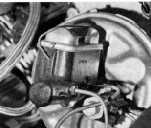
,Donohue knows they were marginal. During the winter he and Cantwell set up a test to find the strongest wheels available. The Minilites won. Now , we know that Penske's small shop doesn't have a fatigue test machine. Whose do you suppose they used? Their test was right to. The only major team that didn't use Minilites was the But Moore Mustang crew. They lost two races and almost one driver because of wheel failure.
Because of the relatively narow rim width, the latest wide tires have resulted in a decidedly pinched look. Firestone has brught its LXX design into the fray quite effectively for this reason, but so far Goodyear has not countered with anything exotic. (Penske is also a Goodyear distributor.)
Managing to fit the big gumballs under the fenders takes some real ingenuity, SCCA says you can make all the room you need, so long as you don't take off any metal or add any, or recountour the fender. Thanks, guys. The internal wheel housings are expanded inward, some of the splash baffles moved out of the way, and then the outside fender is bowed out. This gets very tricky. It requires heating and beating it out, stretching the metal. The result is an extremely stock looking side slash that is noticeable only when parked next to a stock Camaro. Unfortunately these protrusions are the ones that catch the brunt of all the body contact that goes on in this kind of racing, They need rebending nearly every race, and tend to wear a little thin near the end of the season. In fact the entire fender gets rippiely. Acid dipping is illegal . Nobody said you couldn't grind off the wrinkles when repairing a dent. ("Daddy, what's a lightweight Camaro?" "Shut up and sand.")
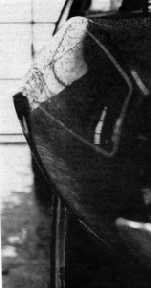
One of the more interesting protests of the Trans-Am season involved the vinyl top used by the Camaros early in the year. It drove the competition SCCA, and the visiting press absolutely batty, because nobody knew why it was there. Some claimed it was hiding an aluminum or fiberglass roof., although the tech inspector's magnets stuck to it. Others claimed it was some kind of super-slippery material that cut the drag.
Penske's story is that he ran them simply to set his cars apart from the crowd. Several other cars running the Trans-Am are also blue, including the Shelby Mustangs, and he simply wanted to look different for quick identification. Also the vinyl is tough, and qould withstand several races before refinishing would be required where as the paint must be touched up after every race, expensive even to Penske.
Curiously the most logical reason for using such a top was ignored. The forward part of a car roof is a negative pressure area. Venting the higher pressure cockpit air into that area would noticeably reduce lift. With a vinyl skin covering a series of pin holes, this could have been accomplished without the inspectors noticing. Nobody ever figured exactly why they ran the vinyl, though and finally got them off on a technicality. (The roofs didn't appear on the homologation papers.) The rules didn't say Penske couldn't use them, so his record was safe.
All engine work is left to Traco Engineering. Penske supplies the parts from his won dealershop. Traco blueprints each engine, dyno tests it and ke4eps it tuned. Traco operates as an independant supplier, and is not on a retainer to either Penske or Chevrolet. Jim Travers does go to most of the races with Penske-as a paid pit crew member-and manages all the care and feeding of his babies.
Power figures are pretty subjective. By Traco's dyno, the engines average around 440 bhp at 7200rpm. This less then the other teams claim, but seems to get the job done. The Chevys are down on power to the Boss 302 Fords, but they win races anyway.
The engines use a suprising number of stock parts, including pistons, rods, cranks, sump, cam and pushrods. About the only thing made by Traco is the valve system, which offers a small improvement over the allready good Chevy set-up. In anticipation of the dreaded rocker ball galling problem, Cheverolet homologated needle bearing rockers. However, Traco found it was just as effective and much cheaper to continue using the 68 system of Micro-sealing the standard rockers. Early engine failures were attributed to connecting rod weakness not encountered until the engine speed was increased to get more competitive power. Subsiquently the design was improved, shot peening added and the problem seems to be solved provided they keep the revs below 7500 and don't try to get more than one race out of an engine.
They have found that it is false economy to try to get more than
one race (plus practice) out of an engine between overhauls. (A full
blow upis clstly, since it requires all new parts.) Overhauls consist
of new rods, rings and a valve job. Everything is crack tested,
including the block. The bearings are so good they are often used
over again. Normally six engines are kept in the works: Two in the
cars, two in overhaul.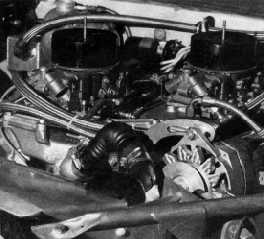
A Schieffer flywheel and clutch along with a stock Chevy disc is used inside a safety bell housing. The M22 "rock crusher" transmission has the usual close ratio gears. A different set of gear ratios was homologated, but never produced, although they could have been effectively used on several courses.
In a form of racing where bleary eyed mechanics allways seem to be changing engines or gearboxes or rear axles right up to the starting grid, the Penske crew displays a remarkable picture of preparedness. At every race. The cars are ready when the arrive at the course. They have fresh paint, they are clean, they have the right jetting and gear ratios and the mechanics are rested (well relatively). There is very little last ditch work done at the race course. Quiet methodical preparation is carried out before the cars reach the track, so the crew can concentrate on going fast, not rebuilding cars.
Between each race the cars are torn down to the "tub" - the unit-body and subframe. This assembly is steam cleaned, and repainted inside and out, including underneath. The engine is sent to Traco, the suspension pieces are magnafluxed and the rear axle is exchanged for a fresh unit containing the proper ratio for the next race. Donohue and Cantwell determine what springs will probably be needed, based on previous experience or educated guess. The suspension goes back on using all new spindles, hubs, bearings and steering knuckles. Brake discs are replaced as are the pads. All fluid systems re flushed, including the oil cooler and lines, radiator and hoses, and the fuel tank and pipes.
The transmission is replaced every two or three races as a precautionary move. A new engine goes in, the fluid systems are primed and the engine is ready to fire. The body work goes back on and any paint touch up work is finished, including pinstriping. ("I want my cars to look sharp;" Penske.) The chassis is given a complete alignment, with anticipated changes incorporated. Donohue and Bucknum have a completely new car for every race. and they look it.
The race winning tactic this year was in their pit stops, every bit as good as those of the legendary Woods Brotheres. Each man has a specified job. If that certain job is not to be performed on a certain pit stop, then he stands back out of the way.
Sunoco designed a secret fueling rig, complete with a cooling
jacket containing dry ice and acetone, A huge hose and nozzle flow
fuel at five gallons a second, about as fast as the cr tank can take
it. The spectacular feul splashes common early in season have been
all but eliminated by a better cap and vent system in the car. Seems
Penske got a pair of $75 alligator shoes ruined by splashing fuel,
hence the improved design. 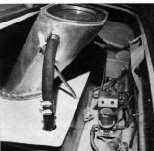
Tire changes are not normally anticipated in most of the races, but when and if, they are ready for those too. Knock off wheels are not allowed, so air wrenches and a five lug nut system are used. Getting a wheel on and off is helped by a special teflon-coated hub bushing. But fitting each individual nut was time consuming. Enter and ingenious device called the lug nut ejector. Five lug nuts are held in a cluster with the same spacing as the wheel. These are slipped over the studs, the ejector plate shoves them home, off the holder ready to be spun tight by an air wrench. Stripping of tthreads is kept to a minimum by coating everything liberally with spray Molybdenum. Low on oil or water? One is hardly able to pour oil into a running engine or pull off a radiator cap on a pit stop. Hence air hose connections re connedted to the oi and water systems. A pressurised cannister of oil or water is plugged in and the pressure in the cannister injects fluid into the hot and running engine.
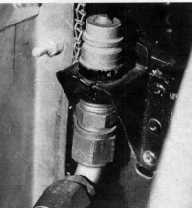 LUG
nut holder allows all five nuts to be started at once, Air wrench
tightenes them down. Tire changers are in the 20 second category,
fast by even NASCAR standards.
LUG
nut holder allows all five nuts to be started at once, Air wrench
tightenes them down. Tire changers are in the 20 second category,
fast by even NASCAR standards.
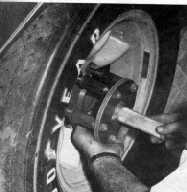
What about 1970? For starterd, there will be an all new "70-1/2 chassis, with improved suspension design and fast back body style. No independent suspension, however. When you get right down to it. a well executed live axle on a big car is not all that much of a handicap, especially on the relatively smooth tracks. Semi-final 1970 rules subject to change at any moment have it that all manufacturers may destroke to arrive at the 305-cid limit, and that only one four-barrel may be used a' la NASCAR. The 70 1/2 Z/28 will therefore be a single carbed 350 (LT1, of Corvette fame) with 370 street horsepower. Fitting last year's crank will bring it back down to a 302. Will they need more horsepower? Doubt it. With only one carb, the air gulping ports of the Boss 302 will no longer give it the distinct advantage it had in '69. and the good torquing (relatively) Chevy should be back in the ball game again. But instead of Sunoco Blue, the cars will be Chaparral White. A Texas Chevy story, J, Hall prop., will be ccampaigning them. With Turbo-Hydros, maybe?
But Penske, Donohue, Cantwell, all the Penske crew, and the sponsors will be wearing new uniforms. For that story, turn the page...
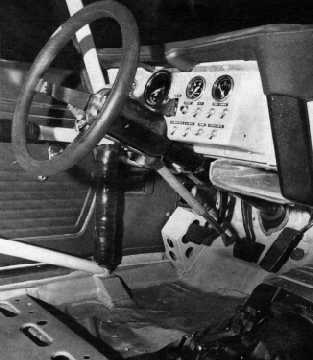 FUNCTIONAL
instrument panel, cool air vent and foot rest aid driver efficency,
Note oil injection connection behind wheel spoke. This allows oil to
be added without lifting hood. Grey paint geves clean apperance,
makes leaks redily visible.
FUNCTIONAL
instrument panel, cool air vent and foot rest aid driver efficency,
Note oil injection connection behind wheel spoke. This allows oil to
be added without lifting hood. Grey paint geves clean apperance,
makes leaks redily visible.
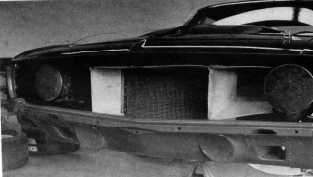 PREPARATION
KNOWS no bounds. Grille removed revaeals ducting and protective
screen in front of Corvette aluminum radiator and Harrison oil coler
(PN 3157804) from your local Chevrolet dealer). Cars undergo complete
overhaul between races, including repainting of even the
undercarriage.
PREPARATION
KNOWS no bounds. Grille removed revaeals ducting and protective
screen in front of Corvette aluminum radiator and Harrison oil coler
(PN 3157804) from your local Chevrolet dealer). Cars undergo complete
overhaul between races, including repainting of even the
undercarriage.

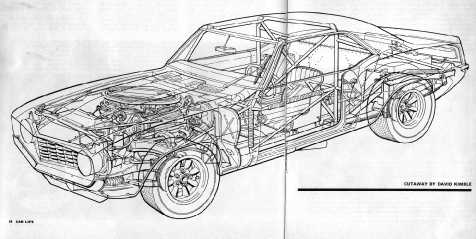
|